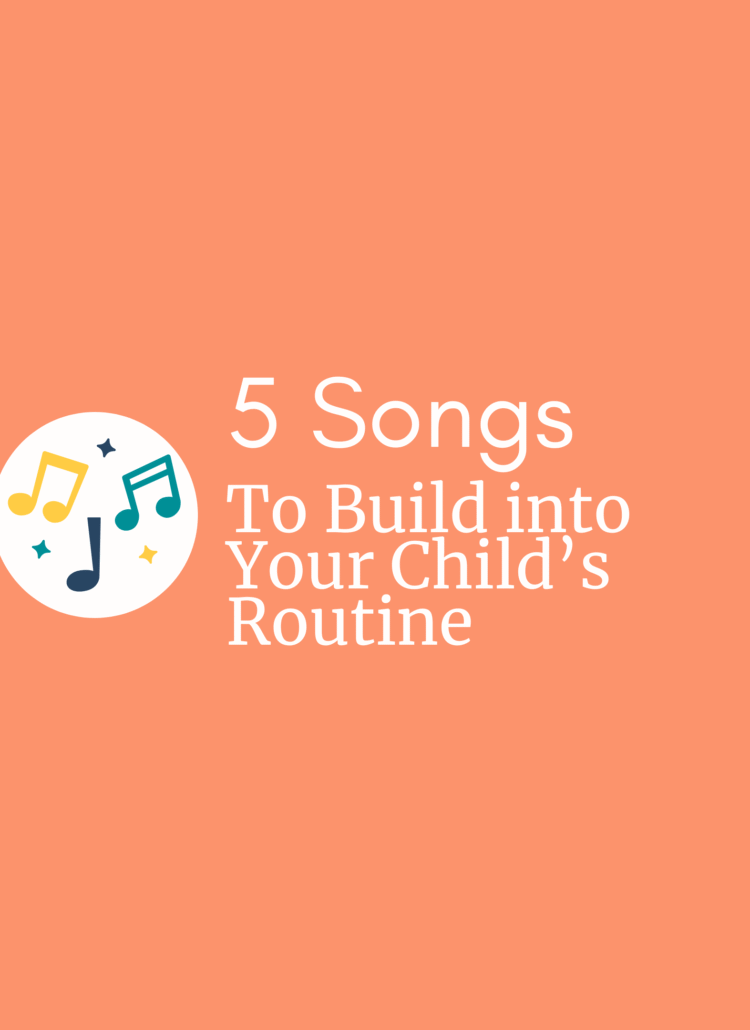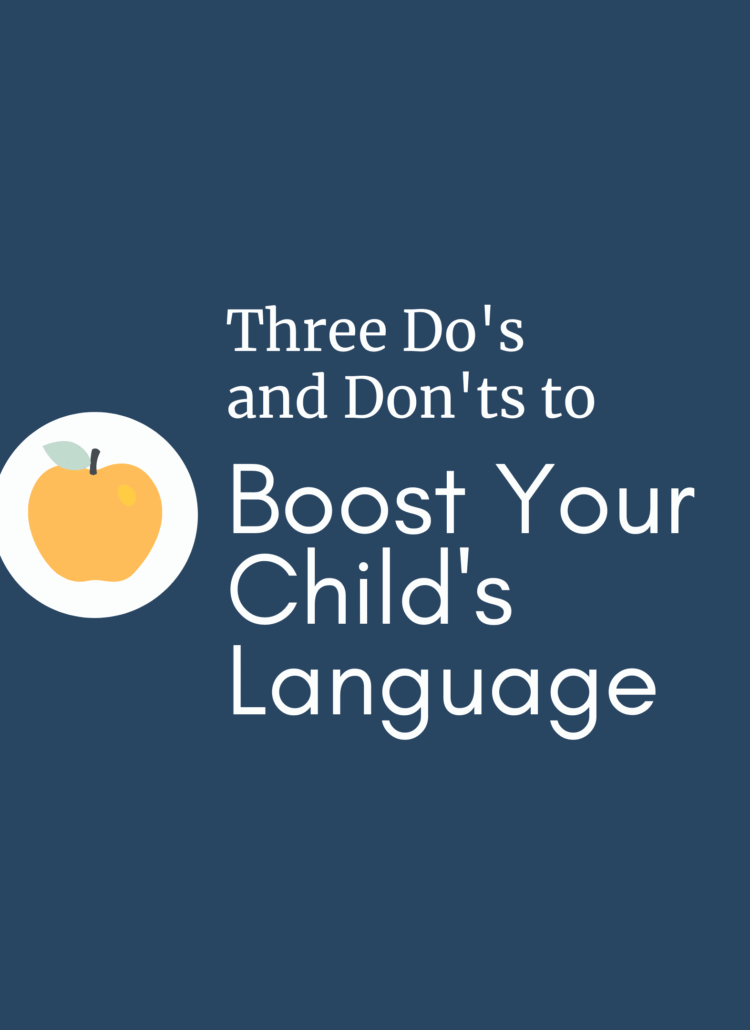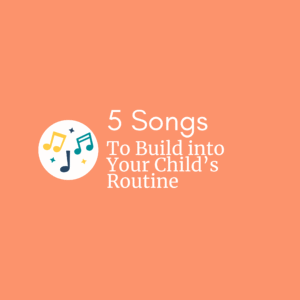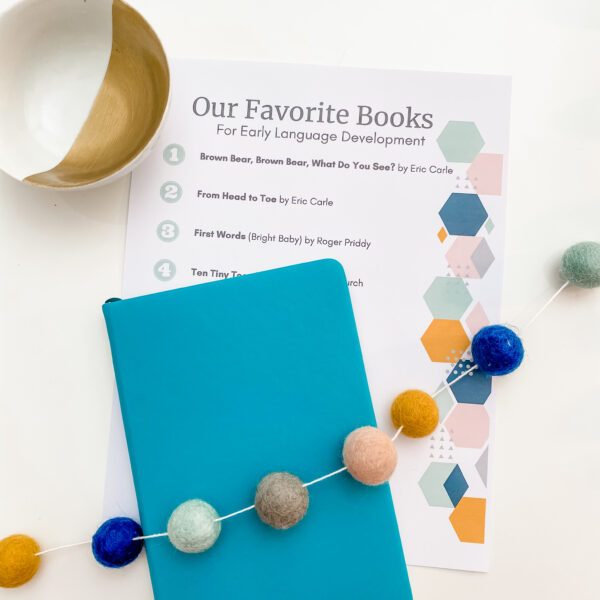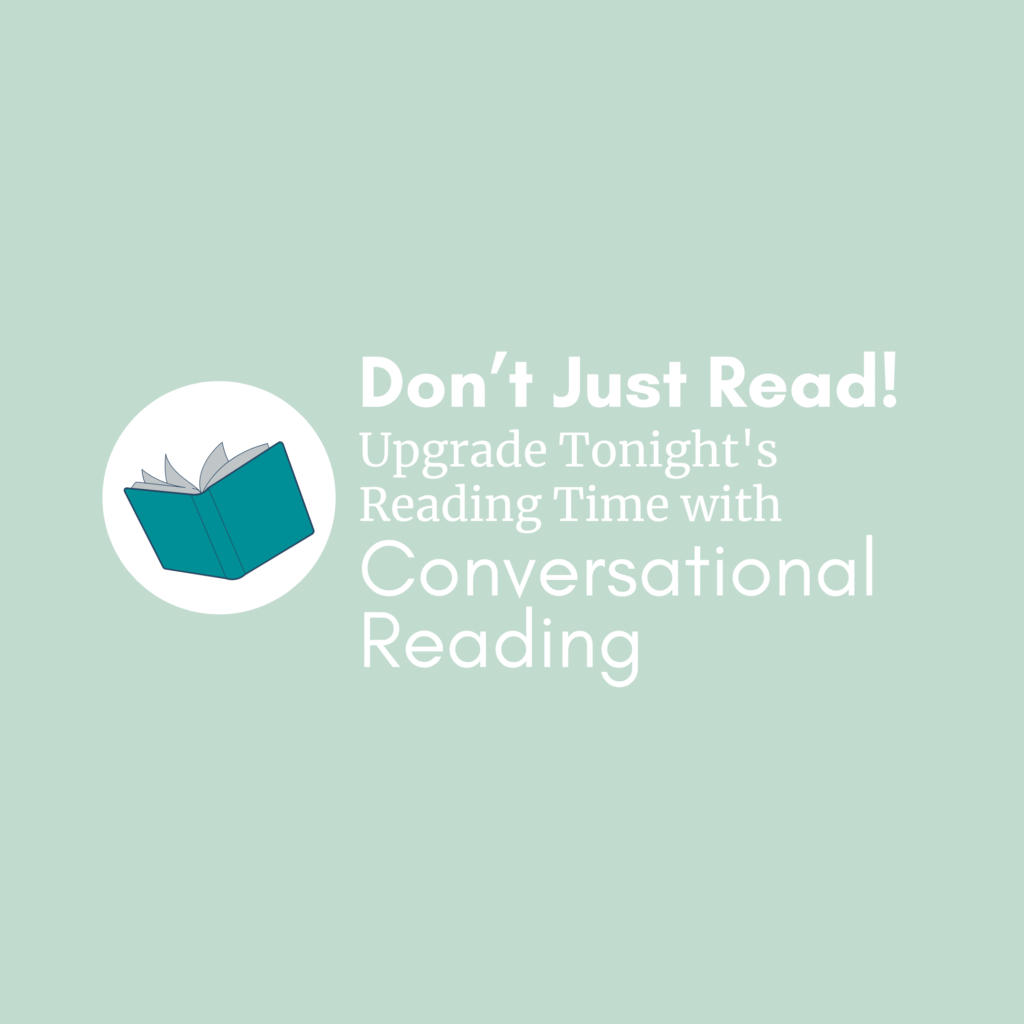
In my home growing up, books were a foundational part of our bedtime routine.
My parents kept three large bookshelves in the upstairs bedroom, all dedicated to children’s books.
Every night, we were each allowed to choose two books to contribute to our book reading time.
Some of the books were read over and over, night after night. They were favorites that we always looked forward to being read to us.
My favorite was when my parents would ask us questions about the story or talk with us about the characters.
Or even let us make up our own alternate ending!
Reading books is great. Wonderful, really!
But if you want to use that time to really help support language development, don’t just read. Use conversational reading!
What is Conversational Reading?
The actual term for conversational reading is “dialogic reading.”
The word “dialogic” is taken from the idea of having a dialogue – a back-and-forth conversation.
Although the phrase “dialogic reading” is what is used by researchers in academic studies, I am use the phrase “conversational reading” because it is a little easier to understand.
Conversational reading is interactive. It means to interact with your child while you are reading.
When you read a book to your child using conversational reading principles, you are not just reading the words on the page.
You are also talking about what is happening, commenting on the characters, asking questions, and relating the story back to your child’s own experiences.
All these interactions help make book reading a more connected experience for you and your child and they help strengthen your child’s language skills.
Benefits of Conversational Reading
Researchers have found many benefits to using a conversational reading style.
Overall, when conversational reading was used with toddlers, they were found to have an increase in their expressive language (Cutspec, 2004) while preschoolers spoke in longer sentences and had larger vocabulary (Cutspec, 2006).
One set of researchers reviewed studies completed by other researchers on the topic of conversational reading to see the benefits noted in other studies. They reported that when a conversational reading style was used, children found reading to be more enjoyable, had more motivation to read, and there were stronger parent/child bonds while parents were found to have more confidence and less stress. (Pillinger & Vardy, 2022).
Another organization found that when conversational reading principles were used with children with disabilities, there were positive effects on communication and language (What Works Clearinghouse, 2010).
Finally, one 18-month study of children between two months and four years found that just reading books (without talking about what was happening in the books) had NO effect on the language development of children (Zimmerman et al., 2009). That is so surprising to me!
Truly – don’t just read!
Conversational Reading in Action
Below are the steps for conversational reading (adapted from What Works Clearinghouse, 2010 and Whitehurst, n.d.).
Before getting started, be sure to choose a book that your child is interested in. It’s more fun for everyone if the book is one that holds your child’s interest.
The first time you read a book to your child, focus mainly on reading the book. Use the following strategies when you re-read the book for the 2nd (for 22nd!) time.
As you repeat these steps with the same book over time, your child will take on more of the storytelling and you will take on more of the listening role.
STEP 1. Ask a question or make a comment.
When looking at the cover of the book or after reading the first page, ask a question or make a comment.
For a child not yet using words or who is using one word at a time
You could point to a ball on the cover and say, “Ball. I see a ball. Ball.”
For a child using two words at a time or who is using short phrases or sentences
You could point to a basket on the first page say, “What is in the basket?” If you child has more developed language, try using questions that start with “How,” “Who,” or “Where.”
STEP 2. Wait for your child to respond.
Give your child a moment to respond to your comment or question.
For a child not yet using words or who is using one word at a time
Your child might respond by pointing to the ball or she might imitate you and say, “Ba,” for “ball.”
For a child using two words at a time or who is using short phrases or sentences
Your child might respond to your question and say, “Red apple!” or “It’s an apple.”
STEP 3. Respond to your child.
If your child responds to your comment or question, acknowledge them.
For a child not yet using words or who is using one word at a time
Respond to your child’s action or word by saying, “Yes! A ball!” This response is expanding on what your child said.
For a child using two words at a time or who is using short phrases or sentences
Respond to your child’s word or sentence by saying, “Yes! There are two apples; a red apple and a green apple.” This response is expanding on what your child said.
STEP 4. Repeat the previous steps on other pages of the book.
Types of Questions and Comments to Use
Here are five prompts you can consider using.
1. Fill-in-the-blank.
This prompt is great to use in a repetitive book, like the book Brown Bear, Brown Bear, What Do You See? To use this type of a prompt, pause to let your child finish a well know sentence, like this, “Brown bear, brown bear, what do you …” Then wait to see if your child says, “See?”
2. What’s happening.
This prompt is great for books that have detailed illustrations. In the middle of the book, ask your child, “What’s happening in this picture?” This encourages your child to describe what she sees.
3. Questions.
Ask your child about something that happened in the story to see if they remember. After finishing the book, you could ask, “What happened to the blue train when it got to the station?”
4. Review.
These are the typical questions that start with, “What,” “Where,” “When,” “Who,” “How,” and “Why.” Know that “What” questions are typically best for children just learning language and “Why” questions are better for children with more developed language.
5. Experience.
If your child has had experiences related to something happening in the book, help make the connection. If you are reading a book about the beach, you could say, “What did we do when we went to the beach?”
FAQs
How often should I use these steps?
You can repeat steps 1-3 on every page or almost every page of the book.
What if I ask a question or make a comment and my child doesn’t respond?
Give your child a few seconds to respond. If he doesn’t respond, answer the question for him or make another comment and move to the next page. The goal isn’t to demand words from your child but present the opportunity to interact.
What if my child loses interest?
We want reading to be a positive experience for your child. If your child loses interest, you don’t have to finish the book. Switch to a different book or move on to a new activity. You can always try again later.
Summary
Reading is great. Conversational reading is even better.
Reading exposes your child to vocabulary, stories, and ideas. Conversational reading gets your young child involved and interactive in the reading process.
Choose a book, select a strategy, and jump into conversational reading.
Your reading adventure awaits!
References
Cutspec, P. (2004). Influences of dialogic reading on the language development of toddlers. Bridges: Practice-Based Research Synthesis, 2(1), 1-12.
Cutspec, P. (2006). Effects of dialogic reading on the language development of 4- and 5- year-old children. Bridges: Practice-Based Research Synthesis, 4(3), 1-15.
Pillinger, C. & Vardy, E.J. (2022.) The story so far: A systematic review of the dialogic reading literature. Journal of Research in Reading, 45(4), 533-548. https://doi.org/10.1111/1467-9817.12407
What Works Clearinghouse. (2010, April). Dialogic Reading. Rockville, MD: Author. Retrieved June 6, 2025, from https://ies.ed.gov/ncee/WWC/Docs/InterventionReports/wwc_dialogic_reading_042710.pdf
Whitehurst, G.J. (n.d.). Dialogic reading: An effective way to read aloud with young children. Reading Rockets. https://www.readingrockets.org/topics/early-literacy-development/articles/dialogic-reading-effective-way-read-aloud-young-children
Zimmerman, F.J., Gilkerson, J., Richards, J.A., Christakis, D.A., Xu, D., Gray, S., & Yapanel, U. (2009). Teaching by listening: The importance of adult-child conversations to language development. Pediatrics, 124(1), 342-349. https://doi.org/10.1542/peds.2008-2267
